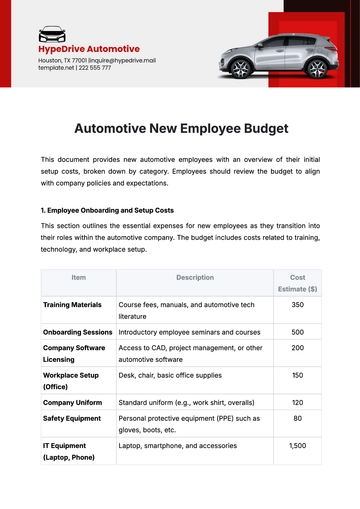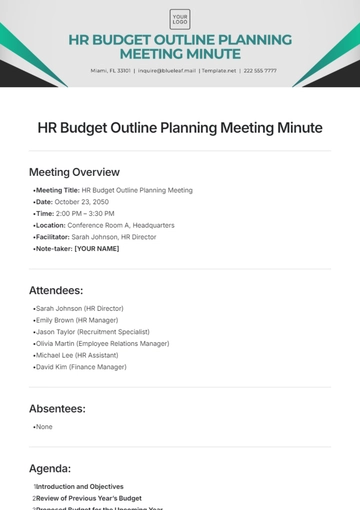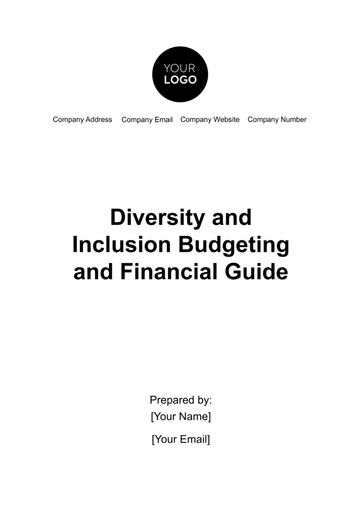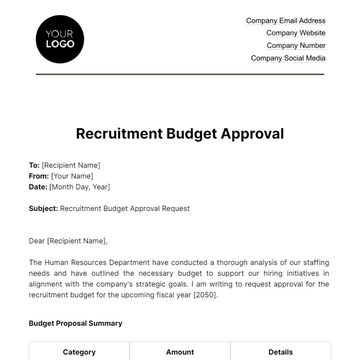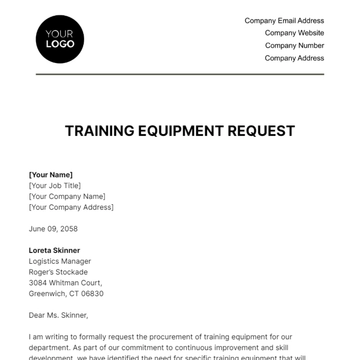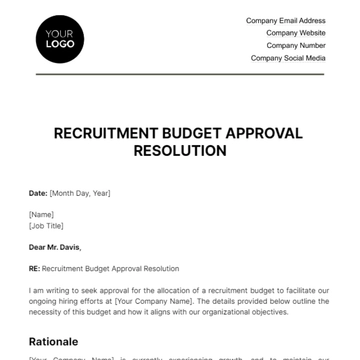Free Diversity and Inclusion Budgeting and Financial Planning Guide HR
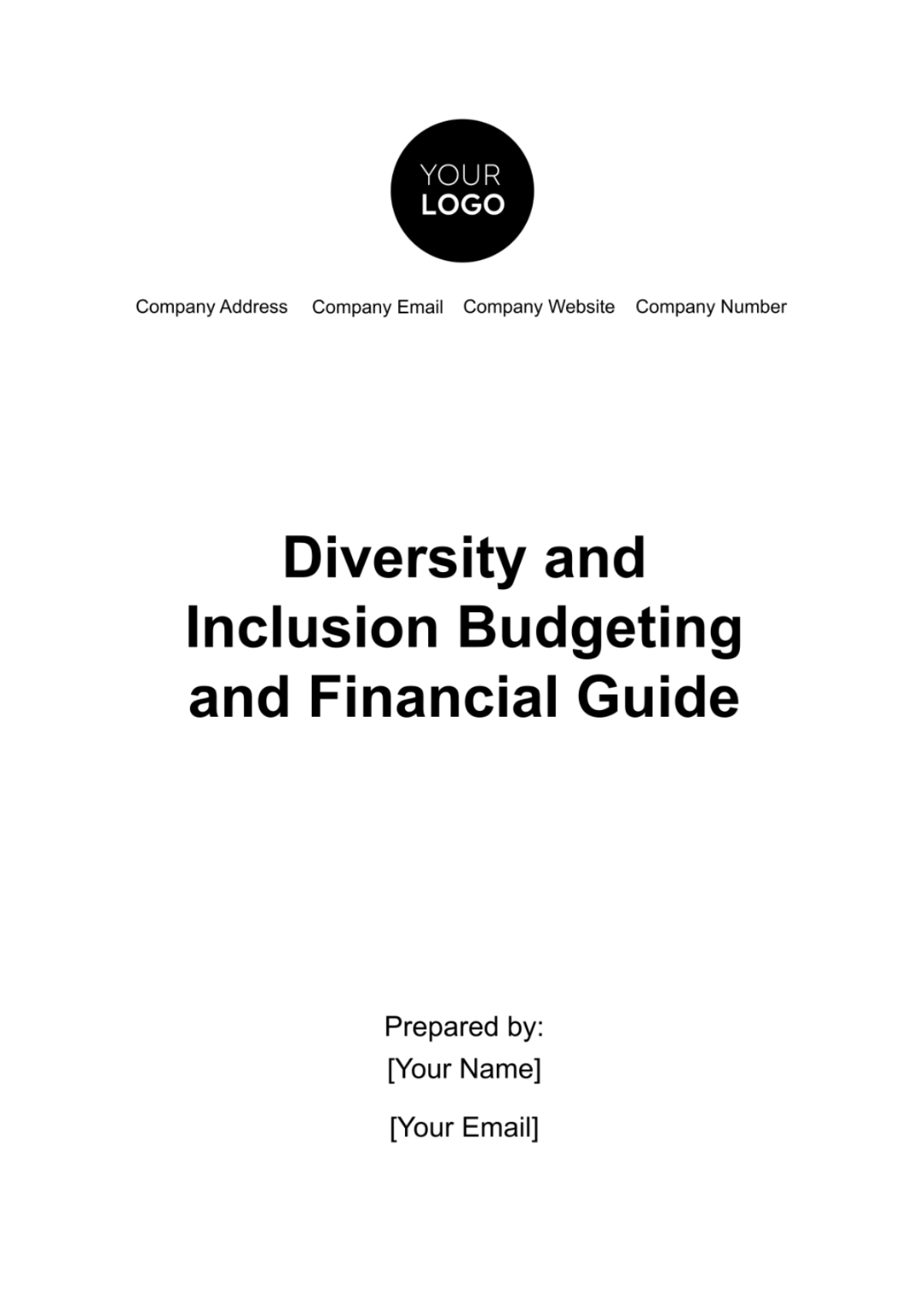
Prepared for: [Your Company Name] Prepared by: [Your Name]
Guide Version: 1.0
INTRODUCTION
Welcome to the Diversity and Inclusion Budgeting and Financial Planning Guide, a comprehensive resource designed to assist [Your Company Name] in strategically integrating diversity and inclusion (D&I) initiatives into our financial planning processes. In an era where diversity is a strength, not an option, this guide offers practical steps to ensure our financial commitment to D&I aligns with our values and business objectives.
THE BUSINESS CASE FOR DIVERSITY AND INCLUSION (D&I)
D&I in the Modern Workplace
In today's rapidly evolving business landscape, the definition of diversity has broadened to encompass more than just race and gender. It includes a wide range of attributes such as age, ethnicity, gender identity, sexual orientation, disabilities, and diverse perspectives. Embracing this broader understanding of diversity enhances our organization's adaptability and resilience.
The Benefits of D&I for Business
The strategic integration of D&I into our corporate culture and financial planning offers numerous advantages, some of which are presented in a table below:
BENEFITS | EXPLANATION |
Enhanced Innovation | Diverse teams bring a wide range of perspectives and experiences, leading to creative solutions, novel ideas, and innovation that drives product development and market competitiveness. |
Improved Decision-Making | Inclusive teams encourage open dialogue and debate, leading to well-informed decisions. Diverse viewpoints challenge assumptions, resulting in more effective problem-solving and strategic planning. |
Increased Employee Satisfaction | An inclusive workplace fosters a sense of belonging and psychological safety. This boosts overall employee satisfaction, engagement, and morale, leading to higher productivity and reduced turnover. |
Better Talent Attraction and Retention | Organizations committed to D&I are more attractive to diverse talent. They also retain employees longer, reducing recruitment and training costs. |
Strengthened Brand and Reputation | Demonstrating a commitment to diversity and inclusion enhances brand reputation and public perception, attracting a broader customer base and fostering loyalty. |
Expanded Market Reach | D&I efforts enable companies to better understand and serve diverse customer segments, unlocking new markets and business opportunities. |
Superior Problem-Solving | Diverse teams are more adept at addressing complex challenges by leveraging diverse skill sets and perspectives to develop comprehensive solutions. |
Compliance with Regulations | Compliance with diversity and inclusion regulations mitigates legal risks and penalties, safeguarding the company's reputation and financial stability. |
Enhanced Global Perspective | In an interconnected world, diverse teams provide valuable insights into international markets, enabling companies to adapt and expand globally. |
SETTING D&I FINANCIAL GOALS
Align with Business Strategy
Ensure that your D&I financial goals align seamlessly with your broader business strategy. Consider how diversity and inclusion can enhance innovation, improve customer relations, and contribute to overall business growth. By integrating D&I into your company's strategic objectives, you emphasize its importance and facilitate alignment.
Define Specific and Measurable Outcomes
Clearly define your D&I financial goals with specificity and measurability in mind. For example, instead of setting a vague goal like "increase diversity," specify "achieve a 20% increase in underrepresented minorities within our leadership team by 2052." Establish key performance indicators (KPIs) that allow you to track progress accurately.
Determine Resource Requirements
Assess the resources required to achieve your D&I goals effectively. This includes budget allocation for recruitment, training, engagement initiatives, and any other necessary expenses. Ensure that your financial goals are ambitious yet realistic, considering both the impact on your organization and the availability of resources.
Establish Accountability
Assign ownership of D&I financial goals to specific individuals or teams within your organization. Accountability ensures that progress is monitored, challenges are addressed, and milestones are achieved. Regularly communicate updates and expectations to keep all stakeholders informed and engaged.
BUDGET ALLOCATION STRATEGIES
Resource Allocation
Allocate a portion of your budget specifically to D&I leadership and resources. Hire or designate a Chief Diversity Officer or D&I manager who can spearhead initiatives, develop strategies, and foster a culture of inclusivity. Invest in diversity-related tools, software, and training programs to support these efforts effectively.
Employee Training and Development
D&I training programs play a pivotal role in promoting awareness and cultural competence among employees. Allocate a portion of your budget to design and deliver these programs. These can include workshops, e-learning modules, and seminars on topics such as unconscious bias, allyship, and inclusive leadership.
Recruitment and Onboarding
Recruiting diverse talent requires resources for targeted outreach, job postings on diverse platforms, and partnerships with organizations that focus on underrepresented groups. Allocate a portion of your budget to enhance recruitment efforts. Additionally, invest in onboarding programs that ensure new hires feel welcome and included from day one.
Employee Engagement and Retention
Allocate resources to initiatives that boost employee engagement and retention. Support the development of Employee Resource Groups (ERGs) and affinity networks that provide employees with a sense of belonging and opportunities to connect with like-minded colleagues. These groups may require budgetary support for events, activities, and resources.
Reporting and Measurement
Effective measurement and reporting are essential for assessing the impact of your D&I initiatives and making data-driven decisions. Invest in reporting tools, software, and resources that allow you to collect, analyze, and visualize diversity and inclusion metrics. Allocate a portion of your budget for conducting surveys, assessments, and audits to gauge progress and identify areas for improvement.
FINANCIAL PLANNING STRATEGY
Annual D&I Budget
Creating an annual D&I budget is a fundamental step in supporting our diversity and inclusion initiatives. This budget should be designed to align with our short-term objectives and adapt to the changing needs of the organization. Here's how to approach it:
Goal Alignment: Ensure that the budget aligns with specific D&I goals for the coming year. These goals should be SMART (Specific, Measurable, Achievable, Relevant, Time-bound) and directly contribute to the overall business strategy.
Resource Allocation: Allocate funds strategically across various D&I programs and initiatives. Consider the needs of employee training, recruitment, engagement, and data analysis. Allocate resources to employee resource groups (ERGs) and diversity councils to support their activities.
Continuous Review: Regularly review the budget throughout the year. Monitor spending, assess program effectiveness, and make adjustments as necessary. Use feedback from D&I leaders, ERGs, and employees to fine-tune the budget allocation.
Flexibility: Be prepared to adapt the budget based on evolving circumstances. Market changes, shifts in organizational priorities, or unforeseen challenges may require adjustments to ensure D&I success.
Multi-Year D&I Financial Strategy
While an annual budget is crucial, a multi-year D&I financial strategy provides a more comprehensive and sustainable approach. This long-term plan ensures that D&I remains a core element of our organizational culture. Here's how to develop a multi-year financial strategy:
Long-Term Vision: Begin by outlining a clear long-term vision for diversity and inclusion within [Your Company Name]. This vision should be closely aligned with the company's mission and values.
Resource Forecasting: Project the financial resources required to achieve your long-term D&I goals. Consider the growth of the organization and the evolving landscape of D&I best practices.
Phased Approach: Divide the multi-year strategy into phases, each with its set of objectives and budget allocations. Phases might include building a diverse talent pipeline, fostering an inclusive culture, and measuring the impact of D&I initiatives.
Contingency Planning: Include contingency plans to address unexpected challenges. These could involve budget reallocations or additional resources for specific initiatives that require extra attention.
Regular Review: Revisit the multi-year financial strategy annually to assess progress and make adjustments. Align the strategy with the changing dynamics of your organization and the broader business environment.
SUPPLIER DIVERSITY PROGRAMS
Program Goals and Objectives
Define the specific goals and objectives of your supplier diversity program. These might include increasing the percentage of purchases from diverse suppliers, supporting local economies, and enhancing your company's reputation as a socially responsible organization.
Budget Allocation
Allocate financial resources to support the program. This includes funding for dedicated supplier diversity staff, outreach and engagement efforts, and resources for tracking and reporting on supplier diversity metrics.
Supplier Outreach and Engagement
Budget for outreach activities to identify and engage diverse suppliers. Consider costs associated with supplier recruitment events, matchmaking sessions, and relationship-building efforts.
Metrics and Measurement
Invest in systems and tools for tracking supplier diversity metrics. These tools should enable you to monitor spend with diverse suppliers, assess supplier performance, and report progress to stakeholders.
Performance Evaluation
Plan for periodic evaluations of your supplier diversity program's performance. Allocate resources to assess the impact of your initiatives, make necessary adjustments, and celebrate successes.
EXTERNAL PARTNERSHIPS AND COLLABORATIONS
Partnership Selection
Identify potential partners that align with your D&I goals and values. Assess the financial implications of collaborating with these organizations, including any membership fees, donations, or resource-sharing agreements.
Budget Allocation
Allocate a portion of your D&I budget to support external partnerships. This may include financial contributions, in-kind donations, or dedicated staff resources to manage collaborations effectively.
Resource Sharing
Explore opportunities for resource sharing with partners to reduce costs. For example, co-hosting events or jointly funding initiatives can be cost-effective and mutually beneficial.
Measurement and Reporting
Plan for the collection and reporting of data related to the outcomes and impact of your collaborations. This will help you assess the return on investment (ROI) and make informed decisions about future partnerships.
Continuous Evaluation
Regularly evaluate the effectiveness of your external partnerships. Consider conducting cost-benefit analyses to ensure that your investments in collaborations align with your D&I goals and yield positive outcomes.
D&I METRICS AND DATA ANALYSIS
Data Collection Tools and Systems
Investment in robust data collection tools and systems is vital for effective D&I measurement. Consider budget allocations for:
Software Solutions: Implement data analytics and reporting software tailored to D&I metrics. These tools facilitate data collection, analysis, and visualization.
Data Storage: Ensure secure and compliant data storage solutions capable of handling increasing volumes of D&I data over time.
Data Integration: Allocate resources to integrate D&I data seamlessly with existing HR and performance management systems.
Data Analysts and Expertise
Acquiring or retaining specialized talent is essential for meaningful D&I data analysis. Include budget considerations for:
Data Analysts: Hire or train data analysts with expertise in D&I metrics. Their role includes data interpretation, trend identification, and actionable insights.
Consultants: Engage external consultants or firms specializing in D&I data analysis for in-depth assessments and benchmarking.
Data Privacy and Compliance
Ensure that your D&I data practices adhere to privacy regulations and ethical standards. Allocate budget resources for:
Data Compliance Audits: Regularly assess data collection and storage practices to ensure compliance with relevant data protection laws, such as GDPR or CCPA.
Data Security: Invest in cybersecurity measures to safeguard sensitive D&I data against breaches or unauthorized access.
Reporting and Visualization
Budget for tools and resources that enable clear and insightful reporting of D&I metrics:
Reporting Tools: Use budget allocations to acquire or develop reporting tools that generate user-friendly D&I reports and dashboards.
Visualization Expertise: Employ experts who can translate complex data into compelling visuals and narratives for stakeholders.
ROI Analysis
Consider allocating resources for ROI analysis of your D&I initiatives. Determine how much you are investing in D&I efforts and assess the financial impact. ROI analysis can provide valuable insights into which initiatives are delivering the most significant returns.
Ongoing Training and Development
Budget for continuous training and development of employees responsible for data collection and analysis. This ensures that your D&I metrics remain accurate, up-to-date, and aligned with evolving business goals.
MONITORING AND ADJUSTMENTS
Regular Assessments
Regularly assess the effectiveness of your D&I initiatives and their impact on the organization's overall goals. Consider conducting quarterly or semi-annual reviews to gauge progress. This assessment should encompass not only financial aspects but also qualitative factors such as employee feedback and cultural shifts within the organization.
Data-Driven Decision Making
Leverage the data collected through D&I metrics to inform financial decisions. Look for trends and patterns that can guide budget adjustments. Data-driven insights help you allocate resources where they are most effective, ensuring the highest return on investment for D&I efforts.
Flexibility in Budget Adjustments
Recognize that D&I efforts may require flexibility in financial planning. Be prepared to reallocate resources based on evolving priorities, emerging opportunities, or unforeseen challenges. Ensure that your financial plan can adapt to changing circumstances while still supporting your overarching D&I goals.
CONCLUSION
In conclusion, the Diversity and Inclusion Budgeting and Financial Planning Guide equips [Your Company Name] with the tools and strategies to not only establish a robust financial plan for D&I initiatives but also to continuously monitor and adapt that plan for sustained success. By embracing diversity and inclusion as essential components of your financial strategy, you not only enhance your organization's reputation and competitiveness but also contribute to a more equitable and inclusive society as a whole.
For any further inquiries or assistance in implementing these strategies, please do not hesitate to contact:
[Your Name]
HR Admin
[Your Email Address]
[Your Phone Number]
- 100% Customizable, free editor
- Access 1 Million+ Templates, photo’s & graphics
- Download or share as a template
- Click and replace photos, graphics, text, backgrounds
- Resize, crop, AI write & more
- Access advanced editor
Unveil the Diversity and Inclusion Budgeting and Financial Planning Guide HR Template from Template.net, a pivotal resource for aligning your budgeting efforts with your diversity and inclusion goals. This editable and customizable template facilitates the strategic allocation of resources to support diverse initiatives. Editable in our AI Editor tool, it's a comprehensive guide for ensuring your financial planning reflects your commitment to inclusivity, exclusively from Template.net.
You may also like
- Budget Sheet
- Personal Budget
- Non Profit Budget
- Monthly Budget
- Project Budget
- HR Budget
- Company Budget
- Home Budget
- Weekly Budget
- College Budget
- Business Budget
- Construction Budget
- Small Business Budget
- Hotel Budget
- Annual Budget
- Home Renovation Budget
- Household Budget
- Student Budget
- Grocery Budget
- Marketing Budget
- Corporate Budget
- Startup Budget
- Manufacturing Budget
- Church Budget
- University Budget
- Annual Budget Plan
- Event Budget
- Operating Budget
- Travel Budget
- Food Budget
- IT and Software Budget
- School Budget
- Real Estate Budget
- Sales Budget
- Conference Budget
- Budget Finance
- Freelancer Budget
- Budget Advertising
